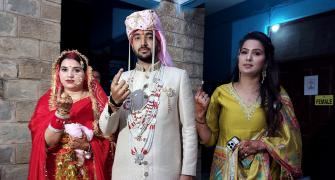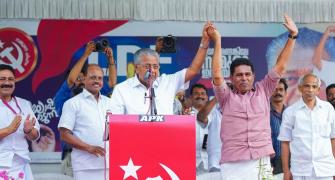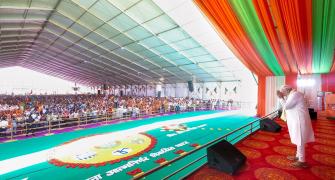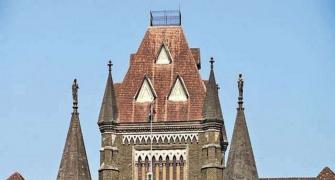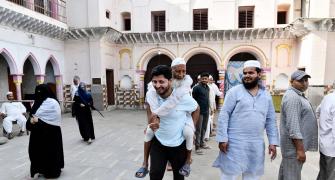As part of rediff.com's continuing coverage on the 1965 War, 40 Years On, Mumtaz Iqbal, a banker in then East Pakistan, looks back at the mood prevalent in the country then, and suggests that the war unleashed forces that enhanced the existing strains in interwing relations.
When war commenced on September 6, 1965, I was a covenanted officer at the Lloyds Bank (later Grindlays, ANZ now StanChart) in Narayanganj, a river port and important jute trading and industrial center 10 miles southeast of Dacca, now spelt Dhaka.
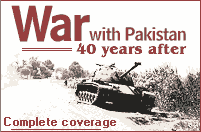 I was the only Bengali in the Lloyds covenanted cadre (boxwallahs). All the others were Brits or Pakistanis. The staffing of foreign multinationals (ICI; Levers; Tobacco) in Pakistan sharply mirrored the poor representation in numbers and position of Bengalis in the bureaucracy and armed forces. This disparity became a combustible issue in Pakistan.
I was the only Bengali in the Lloyds covenanted cadre (boxwallahs). All the others were Brits or Pakistanis. The staffing of foreign multinationals (ICI; Levers; Tobacco) in Pakistan sharply mirrored the poor representation in numbers and position of Bengalis in the bureaucracy and armed forces. This disparity became a combustible issue in Pakistan.
I mention this to show that private sector employment practices replicate a country's public sector architecture of power, a phenomenon that is not unique or limited to Pakistan. But this profile inhibited national cohesion.
The public mood in East Pakistan exhibited a degree of euphoria, even jingoism, normal when hostilities occur. The Bengalis responded as good patriots, rallied behind the government and hoped for victory.
But this feeling was not, and could not be, as robust as that amongst the west Pakistanis. The fighting was happening far away. We weren't physically threatened. Not many households were directly affected by their family members being in harm's way, since the number of Bengali servicemen, especially in the infantry was small.
Moreover, details of infiltration in Kashmir -- we didn't know about Operation Gibraltar then --preceding the actual shooting war were a bit of a mystery to the Pakistani public, especially Bengalis. For them, Kashmir didn't resonate in the same existential way as it did amongst Punjabis.
But Bengalis were also uneasy. East Pakistan was defenceless, with three anaemic brigades. This helplessness was tempered by faint stoicism that India wouldn't or didn't need to attack in the east. The logic was that Delhi gained nothing by dividing her forces and enlarging the conflict.
Pakistan's fortunes, like India's earlier empires, would be decided on the Punjab plains; the difference was this encounter was originating from the east rather than the west, something that hadn't happened that often (except under the colonial Brits!) since Alexandrian times!
It was GHQ mantra that the 'battle for East Bengal would be fought in the West Punjab.' Propounded by the Pakistan Army's second Commander-in-Chief (1948 to 1951) General Sir Douglas David Gracey (1 Gurkhas), this dictum may have had strategic rationale but was political dynamite (The State of Martial Rule, Ayesha Jalal page 85).
We weren't sure whether Delhi's restraint in the eastern theatre was psywar, strategy or biding time. This ambivalence provided scant comfort for Bengalis, isolated from the outside world, with no control over their destiny. These were galling realisations.
We depended on Radio Pakistan, overseas radio and the press for war news. At first, there was confusion and apprehension, with conflicting reports that Lahore had fallen. We were relieved when this proved incorrect.
Our morale bounded with the news that sword of honour winner Major Raja Aziz Bhatti, 17 Punjab, had received the posthumous Nishan-e-Haider (equivalent to the Param Vir Chakra) for repulsing attacks in the Burki area of the Bombanwala-Ravi-Bedian or BRB Canal. This suggested our soldiers were fighting well; Indian attacks were stoutly resisted and not making headway.
The Pakistan Air Force's performance, especially of F-86 fighter pilot Squadron Leader M M Alam, raised our spirits. He reportedly shot down five Indian Hunters attacking Sargodha in one engagement on September 6, becoming an instant ace (Battle for Pakistan: The Air War of 1965, John Fricker.)
The IAF disputes this -- see Laying the Sargodha Ghost to Rest by Pushpinder Singh in Vayu Aerospace Review, November 1985. Post-war findings reduced the nine kills credited to Alam to a still impressive five -- refer Alam's Speed Shooting Classic, Air Commodore M Kaiser, Defence Journal, September 2001.
Much was made that Alam was a Bengali (actually, he is from West Bengal). The Dhaka Municipal Corporation gifted him a house that he never took. Alam got a Sitara-i-Jur'at (Star of Valour) and bar for his exploits. Reportedly he had a checkered career after 1965, found religion and retired as an air commodore in 1982.
Also much publicized was the September 7 attack on the Kalaikunda air base by Dacca-based 14 Squadron F-86Fs (dubbed Tail Choppers) led by Squadron Leader (later Air Marshal) Shabbir Hussain Syed (awarded SJ) in which several IAF planes were destroyed without any PAF loss.
This raid struck some of us as odd. Prudence dictated a reciprocal restraint by Pakistan in the east. While we rejoiced at this exploit, we also wondered when the IAF would retaliate and were puzzled when it didn't, particularly after the raids on Bagdogra, Agartala and Barrackpore.
Was Kalaikunda then not all it was claimed to be? The PAF asserted it destroyed ten and damaged five Canberras and two Hunters on the ground. It's odd to say the least that the IAF would keep bombers so far forward in the east when the war's centre of gravity was in the west.
Within a week, Bengalis were taking the war in stride. We went about our work, studies and other activities as normally as possible under the circumstances. There was no petrol rationing; cars moved with their headlamps half-covered with black paint; a blackout was diligently observed at night, enforced by volunteer wardens. Ack-Ack guns ringed the airport.
Economic, travel and social transactions including crime dropped markedly. There were no shortages or hoarding. Prices were stable or slid as demand faltered. Political activities ceased. Parties issued patriotic statements unceasingly.
But doubts about the war's progress started creeping in from the second week. They first surfaced for me when accounts started circulating about horsemen in green fighting alongside Pakistani forces, and heroic volunteers strapping explosives to their bodies destroyed Centurions and Shermans by rolling under their tracks.
Curiously, these soldiers were not named nor given awards.
These claims of extra-terrestrial intervention and suicidal valour (foreshadowing the LTTE?) were meant to boost public morale but lacked credibility and suggested a heightened level of official anxiety.
Brigadier Qayyum Sher HJ (Hilal-e-Jurat), who made a name for himself on the Lahore front, had remonstrated with Major (later Brigadier) A R Siddiqi that such drivel didn't impress the front-line troops. But the PR machinery continued to churn out unadulterated nonsense relentlessly.
My apprehensions about the war's progress peaked when it was announced around September 20 that a tank battle at Chawinda in the Sialkot sector was the biggest since Stalingrad (August 1942 to February 1943).
I had read enough military history to know that the largest WW II armoured engagement (2,700 German and 3,400 Soviet tanks deployed) was Kursk in July 1943, that is, after Stalingrad; that Stalingrad was a grinding siege fought under terrible conditions between the Red Army and Wehrmacht infantry, and wondered about Ayub Khan's -- or his speech writers' --knowledge or distortion of military history.
I suspect Stalingrad was mentioned so as to resonate with the public because more Pakistanis had heard about Stalingrad as a defining struggle than Kursk (or Kharkov). 'To compare the battle of Sialkot sector with those of WW2 is a cruel joke,' concludes Major Shamshad Ali Khan, who fought at Chawinda (see his Chawinda 1965 -- An Analysis at pakistanidefenceforum.com/lofiversion/index.php).
I didn't miss a single day's work during the war, traveling daily between Dhaka and Narayanganj in a Land Rover with two Brit colleagues (a Scot and a Pommie). I recount a few experiences below.
Probably the funniest one happened a week into the war.
Narayanganj was a somewhat seedy town. Its main street was Quaid-e-Azam Road, along which Lloyds bank was located. Adjacent was the Narayanganj Club. It had seen better days but still put out an impressive lunch (especially fried bhetki with Tartare sauce) served by a waiter in full but somewhat tattered regalia.
Just before noon on or around September 12, there was a huge bang just outside the bank. One rumour was that the IAF had dropped bombs. Immediately, the bank shut its doors.
We contacted various sources to ascertain the cause. It transpired that a three-wheeler cycle rickshaw had burst both its rear tyres simultaneously. We breathed a sigh of relief. The rickshaw puller was roundly chastised.
This experience exposed the jitters below the placid surface.
Lloyds Bank was a major financier of raw jute exports where Marwaris were major players. The Narayanganj branch had the largest number of Lloyds' jute clients including Tolaram Bachhraj, a top exporter.
Tolaram's managing director Kalyanchand Saraogi was quite a character. He was short, dark, with thinning hair, a faint disheveled moustache and the beginnings of a paunch; lacked formal education; dressed modestly but untidily in inexpensive casual clothes and had an impressive mastery over numbers.
Every business day, he would turn up at the branch around noon. His entourage comprised his trusted finance manager, independent jute brokers and assorted hangers-on. He convivially bellowed his opinions throughout the branch in a booming voice; sent the advances staff into a frenzy while they struggled manfully to calculate swiftly how much money he could withdraw (between Rs 5 lakhs and Rs 10 lakhs daily -- a lot of money then); and left in a blaze of cacophony. After that, peace and tranquility would return to the branch.
Lloyds froze Tolaram's accounts on the declaration of war under Islamabad's Enemy Property Ordinance. That stopped Kalyanchand's visits to the branch. At first we relished the silence his absence brought. But after a while, we missed the instant boisterousness his arrival had wrought.
Around September 14, although the jute portfolio was held by an English colleague, my Scots branch manager Steve requested me to visit Rangpur in north Bengal to check on Tolaram's stocks. He explained that the presence of a white man checking jute bales pledged/hypothecated to the bank may be misinterpreted (MI-6 and all that). Could I help?
Of course, I would. This was a chance to earn credits. I had never visited Rangpur. A Cook's tour at bank expense sounded fun. I was young, confident and on top of the world, having married six weeks ago. My parents and new bride questioned my brashness but didn't press their objections.
I traveled by train alone first class leaving Dhaka early morning, reaching Bahadurabad Ghat on the eastern bank of the Jamuna (this is what the Brahmaputra is called when it enters Bangladesh from Assam) early afternoon without mishap or excitement.
The metre gauge in the eastern part of Bangladesh gives way to broad gauge in the north. I crossed by ferry to the western bank and got on another train for Rangpur with a compartment to myself. The train left late evening and creaked and groaned at around 30 mph.
The journey was uneventful till we stopped about 9 pm at a station -- I can't remember the name -- a short distance from Rangpur. There I saw soldiers on the platform boarding the train. The next thing I knew was my carriage door being flung open and a uniformed figure flung himself face down on the empty bench opposite.
After a few moments, our eyes met, and to my delight, I found the newcomer to be Captain (later Major General) Khalid Musharraf BU, relocating with his troops (4 Bengal or Baby Tiger), raised just before the war.
He was commissioned in 1958 in 15/17 Punjab but later transferred to 4 EBR (East Bengal Regiment). The EBR was the only pure Bengali formation in the Pakistan army.
I first met Khalid in late 1963/early 1964 when he was serving with my late brother Rimcollian Major Mahmood Kamal, Guides Cavalry, then commanding K (Kamal) Company of the SSG (Pakistan's commando force) based in Thakurgaon, Dinajpur district.
In 1964, instructed by 14 Div General Officer Commanding Major Gen (later President) Yahya Khan, my brother and Khalid with about a dozen SSG specialists had given training to Naga leader A Z Phizo and 300 men, women and children in Madhupur jungle near Mymensingh in light arms and jungle field craft.
They had taken shelter in East Pakistan to escape Eastern Command's ruthless counter-insurgency drive around 1963, in which Tezpur based IV Corps commanded by Lieutenant General -- later Field Marshal -- Sam Hormusji Framji Jamshedji Manekshaw, MC, and the victor of 1971, may also have taken part along with forces located in Dimapur. Manekshaw, who retired in 1973, speaks fluent Pashtu, no mean achievement for a Parsi born in Amritsar. He was commissioned in 4/12 FFR and later transferred to 8 Gorkha.
Another Naga group went to Yunnan probably following the old Ledo road.
The Nagas were devout Southern Baptists, prayed several times daily, and exfiltrated back to India via Sylhet after about four months. Phizo gave my brother an autographed bayonet in appreciation as a present for my mother.
One of K Company's task was to interdict the six miles wide Siliguri Gap railway not far from Thakurgaon in case of war. From the Tetulia border running alongside a river, it's possible to make out the smoke of the Indian engine. Sensibly, 14th Division General Officer Commanding Major General Fazal Muqeem Khan did not order this raid.
Just as well. An attack on Siliguri probably would have been as abortive as were SSG para raids on Adampur, Halwara and Pathankot air bases without any discernible impact on India's war making capability (see Operation Gibraltar-Role of SSG Para Commandos by ex-SSG CO Colonel S G Mehdi, Defence Journal, July 1988.
In the article, Mehdi also states he counseled GHQ against Gibraltar, which he considered impractical. He later filed a libel suit against General Musa, citing unwarranted allegations in his book My Version against Mehdi.
Evidently, the post war rhetoric amongst and between the participants on both sides appears to be as toxic and incendiary as the actual combat in 1965. The revelations of peace can be as bewilderingly opaque as the fog of war!
The 14th Division was the only one based in East Pakistan that at its best never exceeded four weak brigades from 1947 till early April 1971. Then 9 and 16 Divisions minus its heavy stuff were airlifted from Kharian and Quetta, respectively, to tackle the resistance.
My brother rated Khalid as a hardy soldier with plenty of stamina and a sound tactician. Khalid distinguished himself in 1971 (sector 2 and K Force commander), became Chief of General Staff in 1972 and Chief of the Army Staff on November 5, 1975 before losing his life two days later to dissident troops of 10 East Bengal Regiment -- ironically, a unit he had raised in 1971.
Khalid's presence on the train was reassuring. He was in a gung-ho mood, with high morale, prepared for a fight and confident of winning. We chatted and parted company after reaching Rangpur around 11 pm. We never met again.
I spent the night at the railway waiting room, inspected the godowns the next day, found everything in order and caught the afternoon train to Dhaka. A small damage to the Rangpur railway station was attributed to strafing by IAF Hunter, but I couldn't corroborate this.
That was the closest I got to the war zone, my craving for action satisfied vicariously!
The cease-fire on September 23 was greeted with relief in the east and anger in the west, especially amongst the Punjabis. Many of the latter were convinced Pakistan was winning when Ayub capitulated under Anglo-US pressure.
But Pakistan, fighting on its inventory, was down to two days of petroleum, oil and lubricants or POL, and running short of ammo. Ayub was obliged to call it a day.
There were four EBR battalions in Pakistan's army in 1965 of about 230,000 men organised in eight divisions. (The Military Balance IISS 1964-65) The 1st Bengal (Lt. Col. ATK Haque) defended the BRB Canal line stoutly, and got the highest number of awards of any unit.
Neither Islamabad nor GHQ much publicised this fact. It didn't dovetail with the conventional wisdom that Bengalis didn't make as good soldiers as the 'martial' Punjabis and Pathans. But Lahoris treated Bengali soldiers generously. Shopkeepers often refused money for goods or services.
Opinions differed about Tashkent as over the cease-fire.
Bengalis supported it; Punjabis were livid. This sealed Ayub's fate. Bhutto skillfully used Punjabi resentment to sweep the province in the 1970 election.
The war devastated Ayub; shattered martial myths; highlighted societal contradictions and fatally exacerbated inter-wing tensions. The crack became a chasm.
Field Marshal William Slim's Defeat into Victory is a military classic that informs and entertains. Few -- if any -- of the books on 1965 by Indian or Pakistani servicemen or civilians reach Slim's erudition. Their accounts bring to mind Lloyd George's stern admonition to Field Marshal Douglas Haig that the brass hats shouldn't make the mistake of thinking that the seat of the intelligence is in the chin!
Author's note: This account relies on memory. Facts and anecdotes are used to elucidate. Unless specified, dates are indicative.
Mumtaz Iqbal is a retired banker from Bangladesh with an interest in military history.



